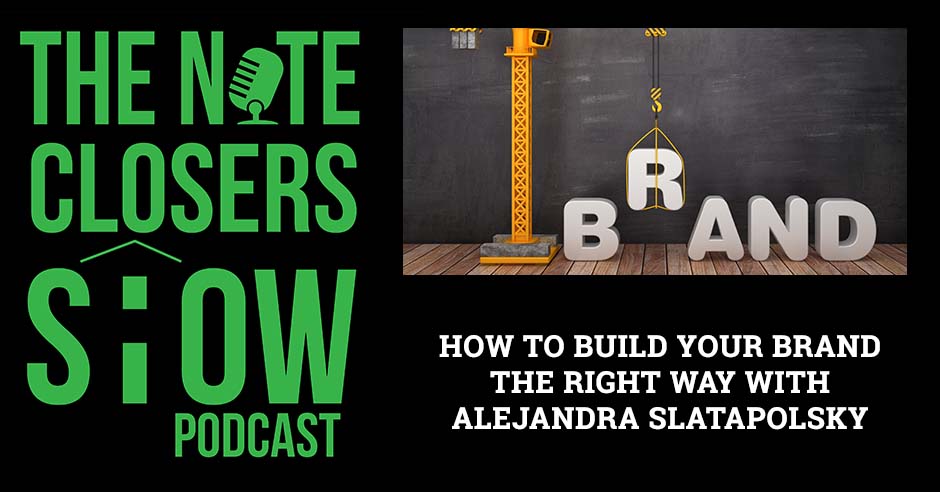
If you want to build your brand, you have to be communicating the right people. You need to be able to find your niche. If you’re all about the notes industry, talk about notes. Only then will people understand where you’re coming from because they are your niche. It’s important to be with them along their customer journey so that you can add some value. Join Scott Carson as he talks with marketing leader and co-founder of Scalta, Alejandra Slatapolsky about the correct and incorrect ways to build your brand. Learn how you can build you brand when it comes to marketing and why being niched down equates to a faster rate of success. Find your niche today!
—
Watch the episode here
Listen to the podcast here
How To Build Your Brand The Right Way With Alejandra Slatapolsky
I’m honored for you to be joining us. I’m excited for you to be part of this episode as we get closer to the 700-episode mark. I want to throw out and say thank you again for reading. I’m excited about our special guest. I was honored to be a guest on her podcast. You are going to love what she has to say, especially for those of you guys and gals out there that are transitioning or looking to do something big in 2022.
She is the corporate communications and marketing leader with over eighteen years of experience in business-to-business financial services, FinTech Law, and technology. She’s an expert that includes leadership strategies, publishing, training, and education. She’s ideally here to be on the show. She’s designed and implemented successful communication strategies, drawing from a background in marketing SEO, strategic event planning, journalism, public relations, training, and education. We are honored to have the amazing Alejandra Slatapolsky joining us here from Hollywood, Florida. What is going on, Alejandra? How are you doing?
I’m good. How about you? Thank you for having me.
I’m doing great. We spoke last right before the end of 2021. How’s the New Year treating you so far?
It has been great. It’s a little crazy, honestly. Everybody decided to follow it up and get things done. We are trying to catch up. Through the holidays, we had COVID at home. I was knocked out too. I’m back to full energy into 2022.
COVID will knock you on your butt for sure. We are glad you are back healthy again and rocking and rolling. You work with a variety of different businesses, especially on the financial side. In searching in some of your articles, the last few months are very interesting on the fund and raising or a rollout strategy. What are you seeing what’s working in this crazy chaotic world for companies or funds and raising capital these days?
Honestly, since the pandemic started, all I could think about I’ve seen is every single trend that we’ve seen coming has accelerated. On that note, every single thing that used to be is now truer. In terms of what works and what doesn’t, I’m in touch with a ton of entrepreneurs, startups, and people looking for transitions. A close friend of mine told me many years ago, and I always say this too. He used to be a trader and now an entrepreneur too, “The best way to invest is to only invest in what you understand.” I remember that all the time and have that in mind in whatever decision I need to make and whenever I talk to anybody.
I remember he told me these stories. A friend of mine came, he’s a lawyer. He told me, “I want to invest in a sushi restaurant.” I was like, “Why would you do that? What do you know about sushi?” With blockchain, NFTs, and crypto, everything that has been thrown away, accelerated, and become the latest, shining piece of investment that comes your way. You have to be careful in that way. The only thing to read the markets is to go and buy whatever you can be used and see that you can understand and stand behind it.
It makes a lot of sense talking about that. There’s a story out about how the wide receiver, Odell Beckham, from the LA Rams took a $750,000 base salary for the year and had invested all of it into crypto. As we sit now, he’s yielding basically $35,000 because of the big drop-off on that. I’m not saying that he wasn’t an expert.
It means to stay like that. Things obviously rebound. You are exactly right. You got to know what’s going on in the market. A lot of times, it’s investing. It’s not a guarantee. Things are going to go up or stay the same. You can often get hit if you don’t understand the trends. Invest in a sushi restaurant, and I love that because I love sushi but it doesn’t mean I’m a restauranteur or know the cost with all the fresh fish you got to keep.
With whatever you feel comfortable with. Honestly, I talked to my partner, and she tells me my sixteen-year-old grabbed $60 off his savings and put it into an NFT that he liked. He sold it for $5,000, and I’m like, “Get me that kid.” At the same time, he got lucky. That’s the reality of it. He may know some about it and like it but he cannot get cocky about it. You cannot say, “Because I got this one, I’m going to get all the next ones too.”
It’s putting your head down and studying whatever you are interested in and doing it and standing behind your beliefs. It’s the only way also that you are going to be okay with losing the money too. If you stand behind your beliefs, you will be like, “I thought I was doing the right thing.” If you are following somebody else and your following is fine, it’s going to be that much harder on you too.
We’ve seen that definitely in the real estate markets for sure as values keep increasing. I know you’ve seen it down in your neck of the woods. We see here in Austin with 30% and 43% appreciation. It’s crazy. People are like, “Keep going up.” At some point, it’s got to change, and we’ve already started to see a lot of the markets either flatten out or grow a little stale, where obviously the first sign is days on the market increasing or foreclosure starting to increase as people have overpaid for assets and as values drop or comps dropped. You got to know what’s going on in the market. If you are at the top of the market, it’s not always the best time to invest.

Build Your Brand: The best way to invest is to only invest in what you understand. Go and buy whatever you can use and whatever you see that you can stand behind.
I’m very much about psychology too. I see a lot of specialists that focus only on numbers. If you find the stats, you find the trends that you think you found the Holy Grail. I apply these because I’ve learned a ton about communications. That’s my background. In communications, the key is I have to be able to empathize and see where you are coming from and what your thought process is. When you talk about somebody investing in real estate, I’m sure you have all the stats and the market studies, etc. Have you thought about the demographic, the types of people leaving that place, and what’s happening?
When you mention my neighborhood, I will tell you, “It’s great personally.” My example, I said, “It’s great that my home is 20% or 30% more valuable. Let’s sell it. I’m going to make a good profit.” I look at my husband and like, “Where are we going to live?” I’m not going to go live in the middle of the countryside because I’m not interested in that.
I grabbed that and see my neighbors and said most of them go through the same thought process. A lot of investors lose sight of that because they stay only on the paper. They don’t see the market and the psychology behind the market. That’s my thought process because of the communication side. I always look for ways to, “How do you engage? What is your target audience thinking about?”
We’ve seen obviously in the last few years a big communication breakdown in different groups of people who have different opinions a lot of times, whether it’s political, COVID or religion. People are unwilling to listen or empathize with the other side of the argument in a lot of cases. When you are working with your clients that are reaching out communication, what are you seeing some of the biggest mistakes that either businesses or people are making in how they communicate. Lack of obviously is probably the first thing but the failure to think about the opposite side of where that person is coming from or what do you see?
We spoke about this with you. The business that does the best and the most profitable are the ones that find a niche. That’s why when I saw your show, I was like, “Notes Closers, you are focusing on notes, and people will follow you, understand where you are coming from and follow your beliefs because they are your tribe.” The businesses that do well are the ones that find their tribe. I have this conversation every single day, at least twice a day, that it’s about you having to find your niche. Someone asked me, “I found my niche. Now, what would I do?” You make it smaller. The smaller your niche, the better your chance of success. Most entrepreneurs find that very frightening.
I did it myself. I made the same mistake. First, I started to say, “I’m going to do marketing for everybody. Who wants marketing?” It was too broad. Once I focused on what my background was, there was all this finance. It was much easier. Conversations would flow, and people would understand where I was coming from. I understood the market, so they were much more comfortable talking to me.
They didn’t have to explain that much to me, so everything flowed. It’s the same way with any product. You want to go with a niche audience always. If it’s retail, you have the California brands that have the lifestyle for Californians. Whatever it is, find that and make it smaller. That’s what most businesses lose sight of.
You can’t be all to everybody. Unfortunately, in this world of marketing, we judge our success by the number of followers, the subscribers or the bigger the email is, the better a lot of times. It doesn’t necessarily mean everybody is reading your email or following you on Instagram, or if they are, it’s not your ideal client. I had a guy reach out to me a while back and say, “We can take your Instagram from where it’s at to 100,000 followers.” I’m like, “I don’t need 21-year-old girls over in the Philippines. They are not my ideal client.” My ideal client isn’t on that platform for the most part. It’s publicity but communications fall on deaf ears if it’s not the right niche for me.
If your right followers are not following you, they are not going to be interacting with you, and the message is not going to be important. There are a ton of different strategies but I completely agree with that. I keep telling my clients that when we do some podcasting, webinars, or messaging for social media or email marketing, I always say, “I prefer to have a small number of the right people that are a big number of random contacts.”
At first, they are taken aback. They are like, “I only have these many emails.” I’m like, “Don’t worry. They are the people that know you. The campaign is going to be that much more successful. It’s going to grow organically.” I prefer organic growth and niche marketing if you are talking about paid advertising whenever you are doing ads. I make very small niches with very specific messages because those are the best leads. I don’t need to throw money at getting the followers I don’t need.
You probably dealt a lot with that, especially with the algorithms changing, especially the last 12, 24 months with Facebook and Facebook advertising. Someone was talking to me about that. I’m like, “A large audience; they are having to pay more to advertise. Once you niche down your audience, niche it down a couple of other demographics, and it will be a smaller list for you but you will probably be a lot more successful.” I didn’t think it would be but we compared the AB testing, and the one campaign did this number. The smaller campaign did more because we were talking, they were talking, and hitting that nail on the head with the right audience.
You are going to have a higher cost of distribution per lead but the lead is going to be much better quality. We do work and delving into something else but you made me think of that. For me, it’s pretty important what you are doing with your clients once they come in. The customer journey is key, whatever you do in the client experience. I used to have a hedge fund as a client. Hedge funds have a pretty good margin. They are profitable in general. They were paying a fortune per lead, which worked for them because that lead would be a lifetime value of 20X.

Build Your Brand: It’s better to have a small number of the right people than to have a big number of random contacts. It’s going to grow organically because you’re not throwing money at followers you don’t need.
However, once we got to 300 or 400 leads, they couldn’t take care of them. They could not nurture or onboard. They could not make sure they were converted. In marketing, most people always talk about lead acquisition. With a little smarter campaign here or there, you will get leads. The health of your company is going to be determined by the health of your client experience and how you are doing that.
That’s going to create a much more profitable relationship with the client, create referrals and long-term value, and a relationship that’s going to be that much more valuable. It’s typical that people come to me and say, “I want a digital campaign. I want to set up Google AdWords or whatever.” Get that budget, cut it in half, and do that for ads. For the rest of the budget, use it to improve your customer journey. That’s going to build the long-term value of a company much more than whatever lead generation acquisition you can do.
It also leads to the fact that it’s always easier to serve your existing client versus going out and finding new clients. If you can serve them, they are going to be repeat clients. Lifetime value, 20 or 30X what the average lead in the financial industry is. People will pay $50 or more for a lead in the financial industry because there is value to it, whether it’s funding deals or raising capital, buying real estate, it depends on your niche, that aspect of it. That’s a great tidbit there.
I love that nugget. Cut it in half and the other half into that experience after they opt-in. The hello call or the hello video, or helping to introduce them to the culture, or tell them exactly where they need to go because people need to be pointed out what’s the next step a lot of times. A confused mind, as we all know, is a mind that says, “No, it doesn’t buy anything.”
It doesn’t even get me started with the onboarding processes in wealth management. You see the acquisition, and you have the conversion. There are a lot of drops there. There is a lot of work that I’m sure all businesses can do to improve conversion because you already got the lead but you don’t convert them. You must figure out where the biggest drop is and work from there. Prioritize and start working from there.
There is a drop in referrals for sure. There is a drop in the onboarding process with technology companies, FinTech or financial services companies. The consumer is that much more impatient. The average time to drop on an onboarding process is less than four minutes. If you are creating an account and it takes more than 3 to 4 minutes, you drop. A 70% dropped at six minutes.
People stop filling out the forms and move on to something else. I can echo that. I wouldn’t say that’s anything longer. That’s a great point. There’s a trader on the block of distress notes, and they have this long onboarding process. Besides signing an NDA, now they’ve got this website where you got to fill out 35 questions. I’m like, “Forget it.” I’m not even going to fill it out. You are asking questions that you don’t need to know. “I’ve already signed your nondisclosure. Send me the list. If I need to buy something, I will go from there but you are not adding any value on the front end.”
Unfortunately, every single service now it’s compared psychologically to like social media. How easy is it for you to open an account on social media? It’s less than two minutes. Unconsciously, you are expecting that experience. Every single consumer is expecting that. They are going to be a little more patient with you because you are managing their money but not that much. Our generation and the younger ones are also much more conscious about privacy issues. They are going to be like, “Are you sure you need to ask this? Why are you asking this much?”
There is a ton that you can do. Unfortunately, a lot of software companies get away with the terms of the conditions, and nobody reads but in terms of the experience itself, you can definitely put money into that. It’s going to be money well spent in terms between that and ad buying. That’s even against my business but that’s the way I think.
The trends prove that. There are a lot of things that you can do to improve the onboarding or your client’s experience. You wrote an article about going through the headaches of refinancing a house, how you would reach out to mortgage brokers, and they would ask the same exact thing, and you never hear from him after a couple of days. You also mentioned how impressed you were with what Quicken Loans was doing with the personalized video and what they were doing step-by-step for you. Do you want to talk a little bit about how that is and how people can apply something like that in their business?
That was part of my inspiration also to work much more on customer journeys. Quicken Loans, what basically happened was I was looking for a mortgage, and here in Miami, I kept getting referrals from friends. They would send me the contact of a person, and that person would say, “Send me all the information via email.” I’m already conscious of that my privacy. I was like, “I’m going to send all my financial information, all of my life, to you via an email but okay. I will do it.” It was my first time applying for a mortgage. I didn’t know that much. I go through 1, 2, and 3 people. They take days to get back to me. I was like, “I’m tired of it.” I googled and landed on Quicken Loans.
They made me open an online account, and the system tells you, “These are the steps. This is what you can expect. Upload here, and your documentation is protected by ABC.” What impressed me was that throughout the whole process, every single step of the way, they would give me a call, “You uploaded these documents. The next step is this one. Do you understand everything in between? Do you have any questions? Is everything okay?” “Yeah, I’m fine. Okay, let’s go.” “The next step is going to be so and so,” and another call, “You uploaded this document. This is what we are doing.”

Build Your Brand: In marketing, most people always talk about lead acquisition. But in reality, the health of your company is going to be determined by the health of your client experience.
The mix and the integration between the use of technology and the human factor impressed me. After that, every year, whenever my mortgage would suffer modifications. I think it was the taxes from CD, etc. They would send a personalized email with my exact name and numbers on the video explaining where the changes are coming from. I was like, “This is a Holy Grail.” I love them. That inspired me, and that’s a company that happened. I keep referring them because I’m impressed with the customer journey.
I have a couple of other products I can refer them. I have a couple of other products that I’m referring to. Related to my home again, I wanted to decorate, and I’m horrible at decorating, honestly. I looked online, and there’s this app that does the decoration for you. I’m like, “I took it out. We do a consultation with a designer that works on your house.” It’s an amazing app that you scan your house, and it does automatically the rendering. The designer talks to you, and she’s like, “What did you like?” “I like these.” “Do you have kids?” They do the rendering on the app. They have every single piece of furniture. You click and buy it.
I was so impressed because it’s so quick. I can chat with the designer and ask him for another call if I have questions. I have that integration. Five other friends have used it already because I recommend it. That company, I see it online, is not paying that much for advertising. I’ve seen it. They don’t. They are living off of referrals. They are not my friends so I cannot talk about it.
I don’t actually know it but I know because I searched and didn’t see an advertisement. There is a time to save from that only. I have been working with my clients on that too and it’s working. I have a FinTech that also works deeply into the customer journey. He has a 20% improvement in the drop of rate on the onboarding. We still have a long way to go but at least it’s improving. That’s the way to go.
When you talk about an increase in onboarding, do you see success with a number of specific touch points in a day, a week, or a month? When people should be talking, and after a month, it should be something regular or you’ve seen a lot of your clients asking their clients, “How often do you want us to communicate, weekly, daily, monthly or once a year?” What are you seeing as being successful as far as that touch bases?
It depends on the business and what the need is. You can’t standardize that. We are talking about an accountant. You expect to know from them when tax season is approaching and whenever a new law comes out and some opportunities there but you don’t want to hear from them every week or every couple of weeks because you may not have a need. If you are talking about a more retail product, you may have the opportunity to be more in touch. It depends on the product. I would try to go with whatever the customer is telling you. There are law firms that I work with that the client tells me, “Don’t email me. I don’t need to know. I’m fine.”
It took me a while to say, “Why are you not emailing clients?” I keep telling the team, and they are like, “They don’t want to. They are fine.” I’m like, “Are you having calls?” “Yes, that’s what we are doing. Once every quarter, we have a consulting call.” Perfect, that works. It depends on what your firm is. Most entrepreneurs will know in their guts how much their clients want to hear from them and make sure you are giving them valuable content, something that they can use. That’s the only way to go.
A lot of entrepreneurs are yelling at people, marketing-wise, versus listening to their client base or looking at the questions asked and evolving those questions into a solution or content to help answer those questions. If you are getting a question from one client, it’s probably being asked. Give it a second time. It’s definitely somebody’s hot button with your clients in a lot of cases that you have to focus on.
I completely agree. It has to be an answer to a question. It’s always to answer the questions or relate to their situation. There’s a coach that I hired a long time ago who’s amazing at writing emails. I hired him because of his emails. I’m going, to be honest. He’s good. He’s a coach for agency owners, and I love him too. He has a niche. He started writing, saying, “I know what you are going through. I know this is difficult in an agency.” When I read it, I could see that he understood my business. He hadn’t been in my position so that he could help me. That’s a niche too. You have to try to empathize and see what value you can add, and write it up.
We all know that 80% of sales are made of 5th, 6th, or 7th contact in a lot of cases. What are some of those things that you are working with your clients and say, “You got to realize it takes time to build that people have to see what you are offering up multiple times or see the content? How important is that in building the pre-client journey or the pre-client interest for getting that conversion of where they are going to invest with you or buy your product?
That would be Phase 2. If you are in debt with them, they are already leaving. For me, that is a conversion process. How do you convince them to engage with you? You have them in your database. It has varied between industries, retail, and B2B. The number of contacts that you need or touch points is different. For example, if it’s via email, it depends on what we are doing. If it’s via email, try to give them some content of value that they can use in their day-to-day, some little snippet or whatever you can think of that works for them. We have been doing campaigns in which we explain processes.
For example, we have a FinTech that is good at providing onboarding processes and provide some boarding processes for our FinTech. We showed them. You should know what an onboarding process should look like. We give them some information. The next time, we would hold a webinar. In the webinar, we explain that and we don’t sell. The key is don’t try to push products down their throat. You have to earn their trust first, especially in financial services.
You have to show them the path, your capabilities, and your product and earn their trust. They are going to engage with you. Have your niche, and that has to be wide enough so that there is always a timeframe in which your target is going to need your product. Many times, you need to target what is the right one but it’s not the right time. We are so bombarded by media and the amount of information that we receive. The chances of them getting 1 or 2 pieces of information from you, needing your product in a month or two, and remember you, are slim.

Build Your Brand: The chances of your clients getting pieces of information from you are slim. That’s why you need to do a constant flow of content so that whenever they need you, they remember you.
That’s why we do a constant flow of content because that way, whenever they need you, they will remember you. Remembering something that you said sent them two months ago, think about it yourself. I don’t remember every single vendor that talks to me. When I have to look it up, sometimes I make notes. If I’m interested in that one but if not, you delete it. When you need it, you are going to go search for it. It’s a balance of both. Whenever they are searching, you have to make sure you show up.
The whole proverbial no now means not now. You have the opportunity to wow them with your relationship and your content. People can smell somebody who’s trying to cram product down who’s more interested in the sale than the relationship. That’s what we are all about and have to be about in this new world economy building relationships, not selling digits.
That’s a conversation I have every day with clients too. We are producing this content, and they are like, “You are not mentioning my product.” No, I’m not. I’m doing it on purpose. You can mention a product once in a while. It’s like with the balance of content creation for social media. That’s a very common question. “How much content do I do that is content, and how much do I do that is selling my product?” I like the balance of maybe 6 to 1 or 7 to 1, at least. If not, people are not going to follow you either.
That’s a great point there. One of the most well-known books on it comes to marketing. You could say it’s Gary Vaynerchuk’s, Jab, Jab, Jab, Right Hook, where it’s three pieces of content and giving versus the ask. That varies, obviously, depending on the more expensive the buying decision is, or the more cost to it or the relationship is, the more you have to put into the front end to make that conversion. That’s the first step in a long step of keeping that client happy and your bottom line doing well with your repeat clients.
It’s less impulsive. You have to consider how impulsive your purchase decision can be. A lot of financial products are not impulsive at all. It’s going to take a long time for them to make a move. That’s something that you should consider, and that’s part of you. It has to be part of your business plan. I talked to somebody who’s like, “I want to start working with you. I want you to get me investors within fifteen days.” I was like, “I’m sorry. That’s not going to happen. There’s no way. I’m not the gal for you.” He was launching his product.
With our audience reading, we get a lot of people that are still working in their full-time jobs. They want to become a full-time investor and looking to raise capital. One of the things we’ve done is you’ve got to start communicating and adding value to your database, whether it’s one person or 1,000 people, you’ve got to start a communication process at least once a week. Initially, adding value with a video, inviting them to an event or starting that conversation to get the word out. They think about you when they think about investing.
It’s always frustrating because we see with our annual event note camp that we do. We are always asking, “How often are you sending emails out to your database?” It’s literally less than 10% send something out at least once a week, touching base with her audience. What’s more disturbing, Alejandra is 50% never send anything out to their database. They are not doing any marketing. That’s why I’m like, “That’s why you are not raising any capital or closing any deals because nobody knows that you exist out there.”
That’s not acceptable. Most people that are working for corporations have been convinced they don’t need a thought leadership strategy. I have to argue against that. It doesn’t matter what your position is. Your personal brand is still a brand. Why? You are online. Whenever you are online, the perception is built by what you post and what to do or don’t do. If I go online and you don’t have profiles, it’s like, “What do you believe in?” It doesn’t work. If you want to make that transition, the first thing you need to work on is your online profile or your personal brand. Sometimes it’s hard. If you are not a corporation, you have limitations there. They may be able to email people or may not.
If they are not able to maybe say openly that they are crowdfunding or open for investors, do one-on-one communications. Make sure you touch base with key people that you know. I remembered many years ago, the way I started my business was, I swear to God, I went to my LinkedIn and started one-by-one and said, “Should I speak to this guy? Yes. Done. How are you? How have you been? I would be glad to grab coffee together. I wanted to tell you what am I doing?” That’s it, one by one.
If you don’t have time to do that because I’m sure you won’t, because you are working as part of that organization, give yourself a goal. Let’s say three meetings a week, “I’m going to book three meetings a week for 2 to 3 months.” That’s going to build your network. You have to make sure that you are emailing people and doing it in a one-on-one. That’s a one-on-one strategy.
If you are open in your organization, you can work on your profile. That’s the thing to do. Let’s say you are a portfolio manager in some organization. You can definitely work for a profile with general information. You don’t have to do investment advice because that’s what a lot of people say, “I cannot give investment advice openly because my clients will kill me.” I know, but you can talk about the markets. You cannot say where the market is going to go. You can still say what you think about what’s going on. You can still teach things to people because you have your knowledge. You can still teach that. That’s not selling. That’s teaching.
We can sit here and talk strategies all day with it because we have that same type of mindset, Alejandra, but I know your time is valuable. What’s the best way for our readers to follow up with you or follow you, or see some more of your amazing content or strategies out there that you are sharing out there. What’s the best way for people to connect with you?

Build Your Brand: Work on your online profile or your personal brand. If people can’t get in touch with you, then do one-on-one communications. Make sure you touch base with key people that you know.
I’m not going to preach what I didn’t do. You can reach out to me on LinkedIn or Twitter. My name is the only one there. You are not going to find another Alejandra Slatapolsky.
You are the only person on LinkedIn like that. It’s a beautiful last name. What’s the heritage of the last name?
It’s Polish.
I thought it was Polish.
I’m half Polish and half Turkish. I’m raised in Argentina naturally.
Alejandra, thank you so much for coming on. We look forward to continuing the relationship and the conversation at another later date. Thank you for sharing value, nuggets, great thoughts, and content on the Note Closers Show.
Thank you, Scott. It was my pleasure.
—
Read what Alejandro had to say there. There are things you can do. I love her little one-on-one LinkedIn strategy. If you are working for a job and doing that little bit each day goes a long way, three meetings a week. Doing that for 2 or 3 months, you will have 60 to 90 connections there. Remember, the bigger that list doesn’t mean the bigger the profits, know your audience, know your niche, communicate and listen to what they are saying. Don’t be afraid to reach out and touch someone.
We need that more so these days. We are bombarded with the media. It’s those that reach out and are listening, making a difference out there in closing the deal, closing investors or building that long-term relationship for the long run because you never know who’s reading out there. It’s usually not overnight. “I want to opt-in or spend more time with it.” Go out, take some action, and we will see you all at the top.
Important Links
- Alejandra Slatapolsky
- Quicken Loans
- Jab, Jab, Jab, Right Hook
- LinkedIn – Alejandra Slatapolsky
- Twitter – Alejandra Slata
About Alejandra Slatapolsky
 Alejandra Slatapolsky is corporate communication and marketing leader with over 18 years of experience in B2B financial services, fintech, law and technology. Her expertise includes thought leadership strategies, publishing, training and education. She has designed and implemented successful communication strategies drawing from a background in marketing, SEO online strategies, strategic event planning, journalism, public relations, training and education.
Alejandra Slatapolsky is corporate communication and marketing leader with over 18 years of experience in B2B financial services, fintech, law and technology. Her expertise includes thought leadership strategies, publishing, training and education. She has designed and implemented successful communication strategies drawing from a background in marketing, SEO online strategies, strategic event planning, journalism, public relations, training and education.
To give you a better idea of what Alejandra does, she is the host of the show “The Biz of Wealth”.
Alejandra has helped financial services executives, business owners, and c-suite leaders with creating their marketing plans and growth strategies for almost 20 years.

